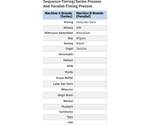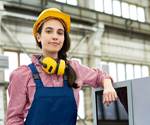How to Duplicate a Process From Press to Press
To adopt the right approach you must distinguish between machine and plastic parameters.
One of the more frustrating practices in injection molding is duplicating a process from one machine to another. I am not saying it is easy. I’ve stated repeatedly that there are hundreds of variables in processing, and dealing with them all is a challenge for everybody. I’m not going to list them all in this article. Instead, I will try to help you establish a strategy to successfully transfer a process from one machine to another. You need to have the right strategy. So what is it?
Simply stated, the strategy is differentiating “plastic” from “machine” parameters—i.e., what the machine “sees” vs. what the plastic “sees”—and duplicating only the plastic conditions. Yet I see a majority of setup sheets and people documenting and chasing machine rather than plastic parameters. The difference? Basically it’s between what you tell the machine to do and what the machine actually does to the plastic.
It is critical to duplicate the plastic parameters as you move a mold from one press to another. My practice is to use a Universal Setup Sheet that allows you have one setup sheet per mold—not per machine. It logs the important plastic parameters so you can reproduce them on any other press. Duplicating the plastic parameters allows you to transfer a mold from one machine to another and get the same part. To clarify, I will distinguish between the “injection velocity” vs. “fill time” parameters that are common to all injection molding processes. One is a machine parameter, the other is a plastic parameter.
Let’s start with the viscosity curve, as shown in the accompanying graph. You have seen it before. Maybe you’re tired of it. But for some reason, its primary message seems to get lost. And that message is to provide data to convince molders that if you change fill time, you change the viscosity of the resin. If you change the viscosity, you change the flow pattern of filling the part, which in turn changes the part.
If you want identical parts from shot to shot, run to run, winter to summer, machine to machine, you have to duplicate the first-stage fill time, not the setpoint for injection velocity. There is a difference. To be clear, what I mean by fill time is the actual time it takes the injection screw to travel from the starting position for shot size and decompression (if any), to the screw cutoff position for transfer from first stage to second stage (or fill to pack), also known as V to P. First stage should make a consistent, slightly short shot by volume, not weight.
The difference between fill time and velocity is that fill time is a measured number on every shot. Velocity, however, is a setpoint the operator inputs to the machine. You can enter in the exact same number for velocity every time you mount the mold, but that will not guarantee you get the same fill time. The machine takes the input of “velocity” in inches or millimeters per second, or cubic inches or millimeters per second, and converts it to some type of electronic signal to control a flow valve or drive motor to push the screw at a velocity.
Due to both electrical and mechanical aspects of an injection molding machine, you may not get the same resultant “fill time” day to day, run to run, year to year. Voltages may vary, a new amplifier card may have been installed, valves wear, varnish may build up on a valve, oil may be at a different temperature, etc. All this means that duplicating the input number for velocity on the controller does not guarantee you get the exact same resulting fill time on first stage. Velocity is a machine parameter. Fill time, however, is a measured number, not a setpoint. So instruct your operators to use whatever number (velocity) they need to reproduce the plastic parameter of fill time.
To fully document this correctly you need the actual fill time, a picture of what a first-stage part looks like (even better is an actual short shot), and part weight for this fill time. All these are measured results, not setpoints. These are relatively easy for an operator to duplicate. Adjustments are made to shot size, cutoff position, and velocity to duplicate the look, weight, and fill time for a first-stage short shot.
Some may argue that they “calibrate” their machines so setpoints will reproduce results. Further, they have a signed and dated document stating such. I hate to be the bearer of bad news, but many of the calibrations are based on voltages, not actual gallons per minute of oil flow, actual or resultant velocities, etc. Ask yourself these questions: How long does the machine stay calibrated? An entire year? When did maintenance last work on it? Did you have a power interruption? And the last straw, how worn is the non-return valve? Ignorance is bliss?
In short, duplicate plastic parameters/ conditions, such as fill time, actual plastic (not hydraulic) pressures, flow path, temperatures, cycle time, cooling, first- to second-stage switchover rate, and all others that are critical to the particular part.
ABOUT THE AUTHOR: John Bozzelli is the founder of Injection Molding Solutions (Scientific Molding) in Midland, Mich., a provider of training and consulting services to injection molders, including LIMS, and other specialties. Contact john@scientificmolding.com; scientificmolding.com.
Related Content
What to Look for in High-Speed Automation for Pipette Production
Automation is a must-have for molders of pipettes. Make sure your supplier provides assurances of throughput and output, manpower utilization, floor space consumption and payback period.
Read MoreA Systematic Approach to Process Development
The path to a no-baby-sitting injection molding process is paved with data and can be found by following certain steps.
Read MoreProcess Monitoring or Production Monitoring—Why Not Both?
Molders looking to both monitor an injection molding process effectively and manage production can definitely do both with tools available today, but the question is how best to tackle these twin challenges.
Read MoreInjection Molding: Focus on these Seven Areas to Set a Preventive Maintenance Schedule
Performing fundamental maintenance inspections frequently assures press longevity and process stability. Here’s a checklist to help you stay on top of seven key systems.
Read MoreRead Next
INJECTION MOLDING: How Different Machine Types Handle Fill and Pack/Hold Times
The procedures are different between series and parallel machines. What type do you have? How can you tell? Here’s what you need to know.
Read MoreLead the Conversation, Change the Conversation
Coverage of single-use plastics can be both misleading and demoralizing. Here are 10 tips for changing the perception of the plastics industry at your company and in your community.
Read More
.jpg;width=70;height=70;mode=crop)
















